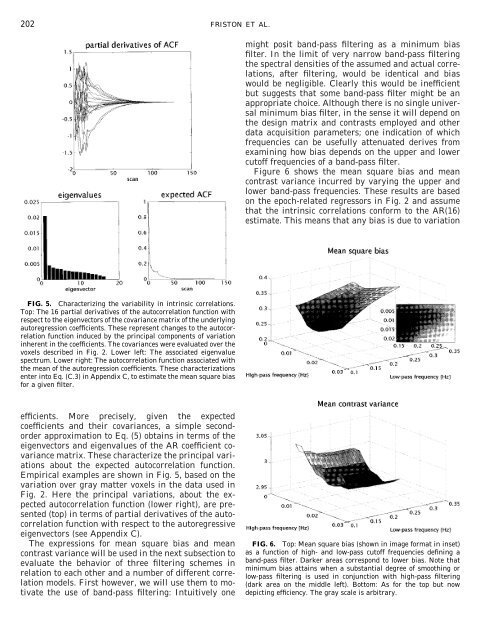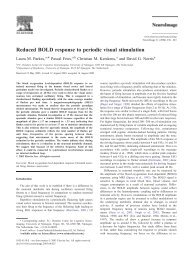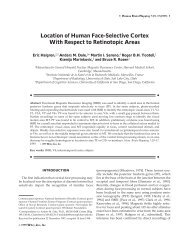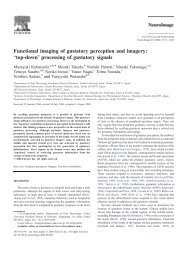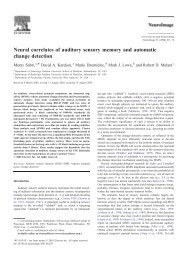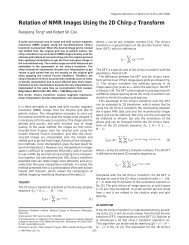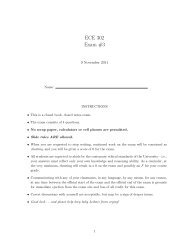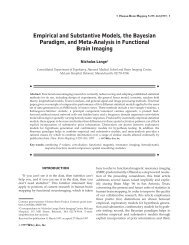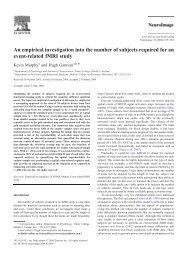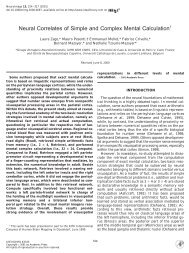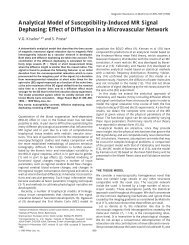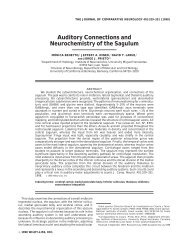Bias and Efficiency in fMRI Time-Series Analysis - Purdue University
Bias and Efficiency in fMRI Time-Series Analysis - Purdue University
Bias and Efficiency in fMRI Time-Series Analysis - Purdue University
You also want an ePaper? Increase the reach of your titles
YUMPU automatically turns print PDFs into web optimized ePapers that Google loves.
202 FRISTON ET AL.<br />
might posit b<strong>and</strong>-pass filter<strong>in</strong>g as a m<strong>in</strong>imum bias<br />
filter. In the limit of very narrow b<strong>and</strong>-pass filter<strong>in</strong>g<br />
the spectral densities of the assumed <strong>and</strong> actual correlations,<br />
after filter<strong>in</strong>g, would be identical <strong>and</strong> bias<br />
would be negligible. Clearly this would be <strong>in</strong>efficient<br />
but suggests that some b<strong>and</strong>-pass filter might be an<br />
appropriate choice. Although there is no s<strong>in</strong>gle universal<br />
m<strong>in</strong>imum bias filter, <strong>in</strong> the sense it will depend on<br />
the design matrix <strong>and</strong> contrasts employed <strong>and</strong> other<br />
data acquisition parameters; one <strong>in</strong>dication of which<br />
frequencies can be usefully attenuated derives from<br />
exam<strong>in</strong><strong>in</strong>g how bias depends on the upper <strong>and</strong> lower<br />
cutoff frequencies of a b<strong>and</strong>-pass filter.<br />
Figure 6 shows the mean square bias <strong>and</strong> mean<br />
contrast variance <strong>in</strong>curred by vary<strong>in</strong>g the upper <strong>and</strong><br />
lower b<strong>and</strong>-pass frequencies. These results are based<br />
on the epoch-related regressors <strong>in</strong> Fig. 2 <strong>and</strong> assume<br />
that the <strong>in</strong>tr<strong>in</strong>sic correlations conform to the AR(16)<br />
estimate. This means that any bias is due to variation<br />
FIG. 5. Characteriz<strong>in</strong>g the variability <strong>in</strong> <strong>in</strong>tr<strong>in</strong>sic correlations.<br />
Top: The 16 partial derivatives of the autocorrelation function with<br />
respect to the eigenvectors of the covariance matrix of the underly<strong>in</strong>g<br />
autoregression coefficients. These represent changes to the autocorrelation<br />
function <strong>in</strong>duced by the pr<strong>in</strong>cipal components of variation<br />
<strong>in</strong>herent <strong>in</strong> the coefficients. The covariances were evaluated over the<br />
voxels described <strong>in</strong> Fig. 2. Lower left: The associated eigenvalue<br />
spectrum. Lower right: The autocorrelation function associated with<br />
the mean of the autoregression coefficients. These characterizations<br />
enter <strong>in</strong>to Eq. (C.3) <strong>in</strong> Appendix C, to estimate the mean square bias<br />
for a given filter.<br />
efficients. More precisely, given the expected<br />
coefficients <strong>and</strong> their covariances, a simple secondorder<br />
approximation to Eq. (5) obta<strong>in</strong>s <strong>in</strong> terms of the<br />
eigenvectors <strong>and</strong> eigenvalues of the AR coefficient covariance<br />
matrix. These characterize the pr<strong>in</strong>cipal variations<br />
about the expected autocorrelation function.<br />
Empirical examples are shown <strong>in</strong> Fig. 5, based on the<br />
variation over gray matter voxels <strong>in</strong> the data used <strong>in</strong><br />
Fig. 2. Here the pr<strong>in</strong>cipal variations, about the expected<br />
autocorrelation function (lower right), are presented<br />
(top) <strong>in</strong> terms of partial derivatives of the autocorrelation<br />
function with respect to the autoregressive<br />
eigenvectors (see Appendix C).<br />
The expressions for mean square bias <strong>and</strong> mean<br />
contrast variance will be used <strong>in</strong> the next subsection to<br />
evaluate the behavior of three filter<strong>in</strong>g schemes <strong>in</strong><br />
relation to each other <strong>and</strong> a number of different correlation<br />
models. First however, we will use them to motivate<br />
the use of b<strong>and</strong>-pass filter<strong>in</strong>g: Intuitively one<br />
FIG. 6. Top: Mean square bias (shown <strong>in</strong> image format <strong>in</strong> <strong>in</strong>set)<br />
as a function of high- <strong>and</strong> low-pass cutoff frequencies def<strong>in</strong><strong>in</strong>g a<br />
b<strong>and</strong>-pass filter. Darker areas correspond to lower bias. Note that<br />
m<strong>in</strong>imum bias atta<strong>in</strong>s when a substantial degree of smooth<strong>in</strong>g or<br />
low-pass filter<strong>in</strong>g is used <strong>in</strong> conjunction with high-pass filter<strong>in</strong>g<br />
(dark area on the middle left). Bottom: As for the top but now<br />
depict<strong>in</strong>g efficiency. The gray scale is arbitrary.


